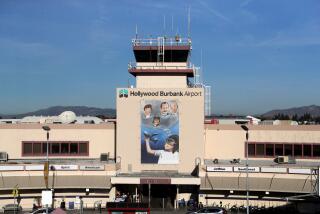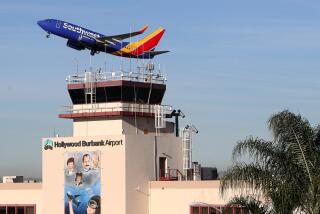FAA Clears 767s for Landings at Burbank Airport
After reviewing the results of test flights last week, the Federal Aviation Administration on Tuesday approved the use of the wide-body Boeing 767 at Burbank Airport, appearing to clear the way for United Air Lines to begin daily service between Burbank and Chicago.
The Burbank-Glendale-Pasadena Airport Authority still must formally approve the new flights. But the FAA action--deciding the plane could be safely used, with conditions--removed the last major obstacle to the United plan for two daily round-trip flights, beginning May 1.
An airport spokesman said a special meeting of the nine-member authority will be called, perhaps as early as Friday, to hold a final vote.
The 767, which is larger than any commercial passenger aircraft now flying into the airport, has already been accepted as meeting the airport’s noise regulations. The authority in the past has taken the stand that, under federal court rulings, it cannot bar from the airport airlines that meet noise and safety standards.
The Boeing 767 carries 197 passengers. It has a wingspan of 157 feet, contrasted with the 109-foot wingspan of the largest commercial jetliner now in use at the airport.
Homeowner and anti-noise groups contend that neither new flights nor larger aircraft should be allowed.
“What we’ve been calling for, for safety and noise reasons, is to reduce flights,” said Richard Close, president of the Sherman Oaks Homeowners Assn. “The FAA, which says we have a serious safety problem, says OK to more flights, which makes the problem worse.”
The FAA ordered the authority several years ago to relocate the 56-year-old terminal, which is closer to both runways than modern regulations permit. So far, however, the authority has been unable to find an acceptable site.
“We think the FAA is inconsistent and is making a potentially deadly situation worse by more flights, more airlines and bigger planes,” Close said.
The airport authority asked the FAA in February for a safety ruling on the 767. The FAA did not answer immediately, but instead required new safety measures by the airport because of the terminal’s proximity to the runways. The FAA barred jetliner takeoffs to the east and ordered the airport to submit a short-term plan by April 18 to move the airplane boarding area.
The authority voted Monday to sacrifice about 500 auto parking spaces to create a new boarding area and delivered the plan to the FAA by messenger Tuesday. The same messenger brought back a letter informing Robert W. Garcin, authority president, of the decision to approve the 767, airport spokesman Victor Gill said.
The letter, from Timothy P. Forte, manager of the FAA’s Western Region flight standards division, contained several restrictions, Gill said.
The FAA said the 767s cannot land toward the west on the airport’s east-west runway, which is 828 feet shorter than the north-south runway. The 767 pilots cannot use visual approaches on southbound landings at night, probably requiring them to make instrument landings toward the east, Gill said. Only the east-west runway is equipped for instrument landings.
More to Read
Inside the business of entertainment
The Wide Shot brings you news, analysis and insights on everything from streaming wars to production — and what it all means for the future.
You may occasionally receive promotional content from the Los Angeles Times.











